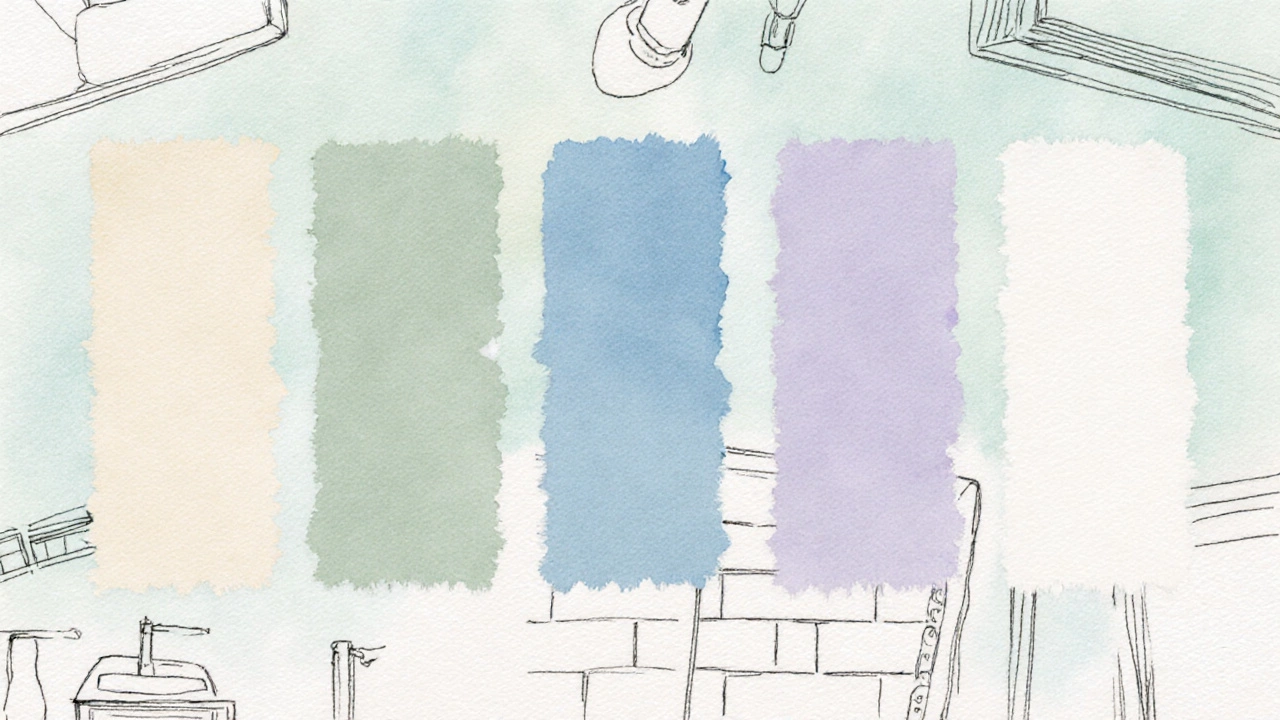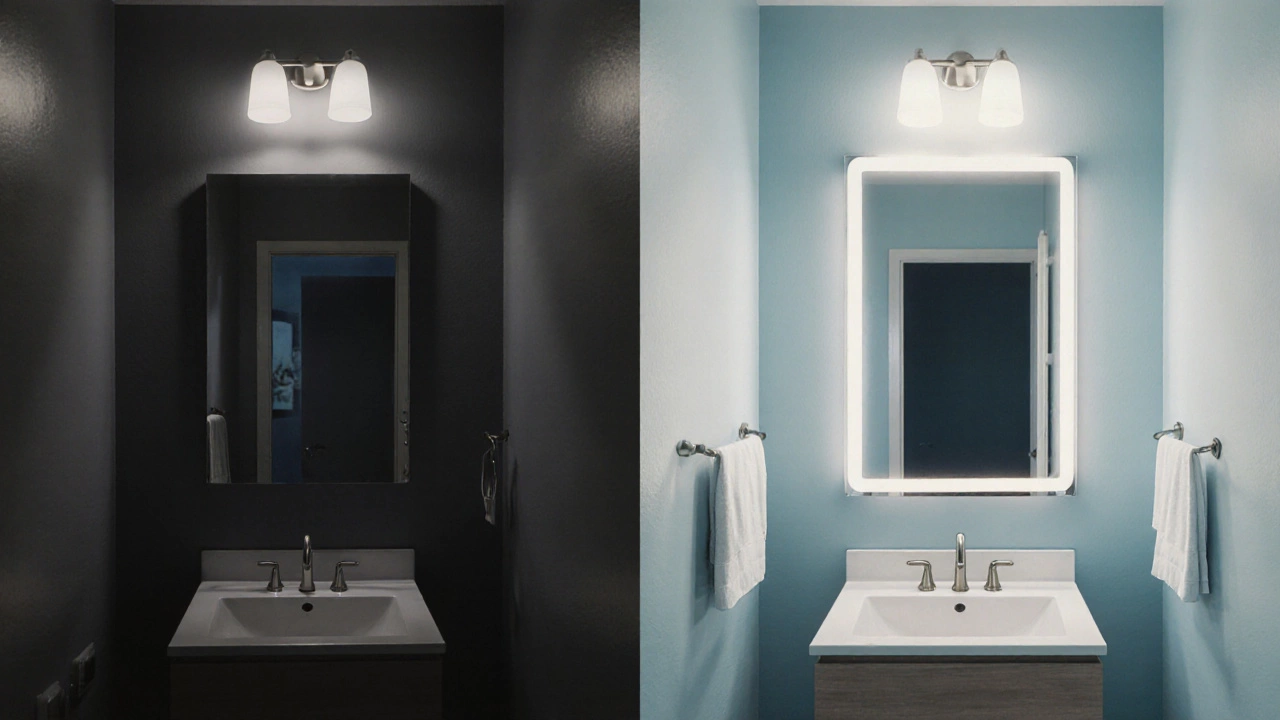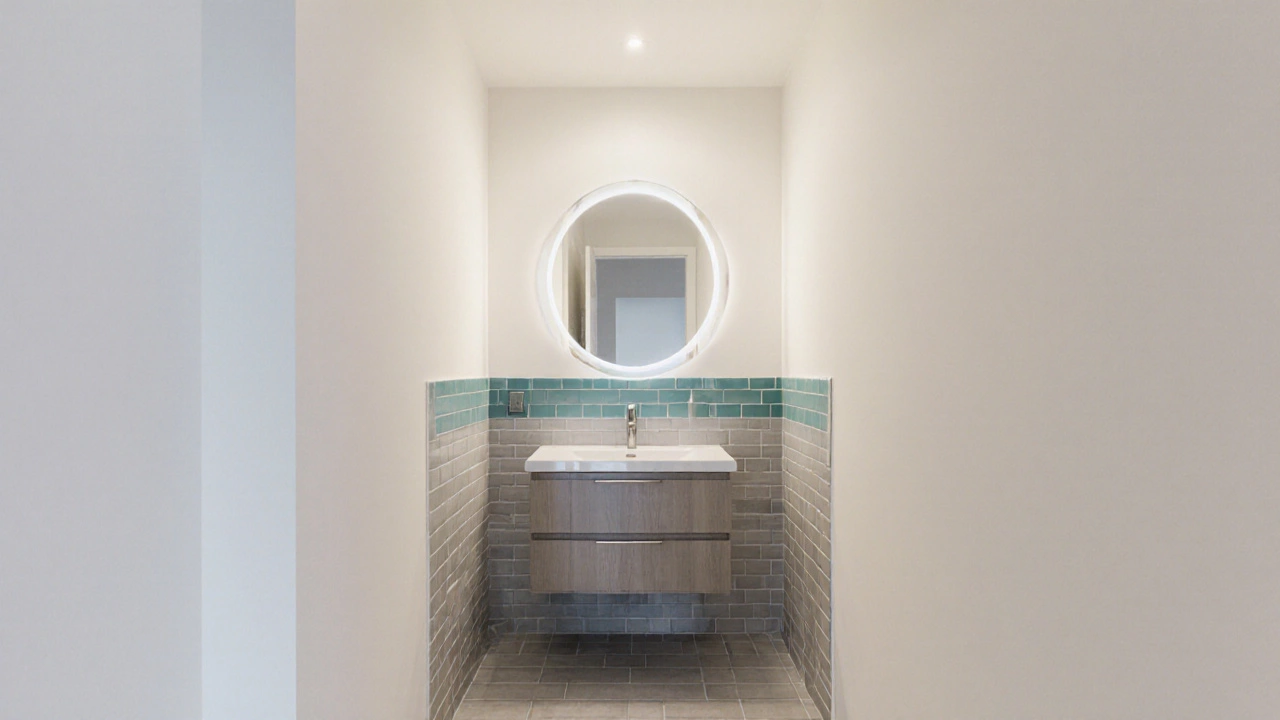Small Bathroom Color Selector
Recommended Shade
Hex Code:
Choosing the right hue for a small bathroom paint color is more than a style choice-it's a trick to make cramped spaces feel airy, bright, and welcoming. The right shade can stretch walls, bounce light, and even mask imperfections, while the wrong one makes the room shrink and feel gloomy. Below you’ll find a step‑by‑step guide, specific shade recommendations, and practical tips so you can walk away with confidence and a fresh look that truly expands your bathroom.
Why Color Matters in Tiny Bathrooms
Our brains interpret color as depth. Light tones reflect more light, creating the illusion of space, whereas deep tones absorb light and pull the eye inward. In a bathroom, where natural light is often limited and fixtures can be bulky, leveraging this visual psychology is key.
Three core principles shape the effect:
- Reflectivity: Lighter shades increase brightness, making corners feel open.
- Temperature: Cool colors (blues, greens) recede, while warm hues (yellows, reds) advance.
- Contrast: Subtle contrast between walls and trim softens edges; harsh contrast can fragment a small room.
Understanding these concepts lets you choose a color that works with, rather than against, the bathroom’s size.
Top Color Families That Expand a Small Bathroom
Below are the five most effective color families for tiny bathrooms, each paired with a brief “why it works” note.
- Soft Neutrals: Off‑whites, warm greys, and gentle beiges reflect sunlight and blend seamlessly with fixtures.
- Cool Blues: Light sky or sea‑foam blues create a fresh, spa‑like vibe and push walls back.
- Muted Greens: Sage or mint tones invoke nature, offering calmness while maintaining openness.
- Pastel Lavenders: Subtle purples add personality without overwhelming the space.
- Monochrome Whites: Pure white finishes maximize brightness but require careful accenting to avoid a sterile look.
Specific Shade Recommendations (with Hex Codes)
Choosing a paint brand is personal, but the following shades have proven track records in small bathrooms-tested by designers and homeowners alike.
- Swiss Coffee (Benjamin Moore CC-150) - Hex #F0EAE1. A warm, creamy off‑white that brightens low‑light spaces while adding a hint of coziness.
- Pale Aqua (Sherwin‑Williams SW 6524) - Hex #E0F2F1. A whisper of blue‑green that feels like a breezy shoreline, perfect for coastal‑themed bathrooms.
- Seafoam Mist (Behr 730C‑2) - Hex #DFF1E7. Soft green‑blue that reflects light and pairs well with white tile.
- Cool Gray (Farrow & Ball 382) - Hex #D1D5D8. A light, neutral gray that adds sophistication without darkening the room.
- Soft Sage (Valspar 4007‑3C) - Hex #CAD5C2. Gentle sage that brings a natural feel and works nicely with wood accessories.
When testing, paint large swatches on opposite walls, observe them at different times of day, and notice how they respond to artificial lighting.

How to Pair Paint with Fixtures, Tiles, and Accessories
A harmonious bathroom looks intentional. Here’s a quick cheat‑sheet to match your chosen shade with the rest of the room.
- Lighting: Use daylight‑bulb LEDs (5000K) to showcase true paint color; warm LEDs (2700K) can make light shades appear yellow.
- Tile: White or light‑gray subway tiles complement neutrals; subtle mosaics in the same hue add texture without breaking the visual flow.
- Mirror: A large frameless mirror reflects wall color, amplifying brightness. Position it opposite the main light source.
- Accent Wall: If you love a deeper hue, limit it to one wall behind the vanity. Keep trim in a crisp white to maintain balance.
- Hardware: Brushed nickel or matte black finishes pair well with cool blues and greens; gold works best with warm neutrals.
Practical Tips for Paint Selection and Application in Moisture‑Rich Environments
Bathrooms demand paints that can handle humidity, occasional splashes, and cleaning. Follow these best practices:
- Choose a paint finish labeled “Bathroom‑Safe” or “Moisture‑Resistant.” Semi‑gloss or satin finishes are ideal-they resist mildew and are easy to wipe down.
- Prep surfaces thoroughly: clean with a trisodium phosphate (TSP) solution, sand glossy spots, and fill any cracks.
- Apply a high‑quality primer designed for bathrooms; it seals the wall and improves color uniformity.
- Roll or brush in thin, even coats. Two coats are usually enough; allow at least 2‑4 hours of drying between coats.
- Ventilate: Run the exhaust fan for at least 30 minutes after painting to speed cure and prevent moisture buildup.
Common Mistakes to Avoid
Even seasoned DIYers slip up. Keep an eye out for these pitfalls:
- Choosing dark colors for all walls-this can make the space feel cramped.
- Using high‑gloss paint on large wall areas-excessive sheen can highlight imperfections.
- Neglecting test patches-what looks good on a swatch board may change under bathroom lighting.
- Over‑matching fixtures-if everything is the same shade, the room loses depth.
- Skipping the primer-especially on tiled walls where paint may not adhere without it.

Quick Comparison of Top Color Families
| Family | Visual Effect | Best For | Typical Shade Example |
|---|---|---|---|
| Soft Neutrals | Brightens, adds warmth | Low‑light rooms, classic style | Swiss Coffee |
| Cool Blues | Creates depth, feels fresh | Modern or spa‑like looks | Pale Aqua |
| Muted Greens | Calming, subtle receding | Nature‑inspired decor | Soft Sage |
| Pastel Lavenders | Adds personality, stays light | Vintage or feminine themes | Lavender Mist |
| Monochrome Whites | Maximizes light, ultra‑clean | Minimalist aesthetic | Pure White |
Next Steps: From Color Choice to Finish
Now that you know which hues work best, follow this short checklist before you buy:
- Pick a shade from the list above that matches your style.
- Buy a bathroom‑safe semi‑gloss paint and a matching primer.
- Gather tools: roller, angled brush, painter’s tape, drop cloths.
- Test the paint on a 2‑ft square on two opposite walls.
- Schedule a day when you can leave the fan on for at least 4 hours after the final coat.
When you’re ready, roll out the color and watch your tiny bathroom transform into a space that feels larger, brighter, and more inviting.
Frequently Asked Questions
Can I use dark paint in a small bathroom?
Yes, but limit it to an accent wall or lower half of the walls. Keep trim and ceiling bright to maintain balance.
What paint finish is best for moisture resistance?
A satin or semi‑gloss finish labeled “bathroom‑safe” offers the right mix of durability and easy cleaning.
How many coats of paint should I apply?
Two thin coats are usually sufficient for even coverage and color depth. Allow proper drying time between coats.
Should I use a primer on tiled walls?
Yes. A high‑adhesion primer ensures paint bonds to glossy tile surfaces and prevents peeling.
Is white always the safest choice?
White maximizes brightness, but it can feel sterile if not accented. Adding subtle color through accessories or a soft neutral keeps it interesting.
